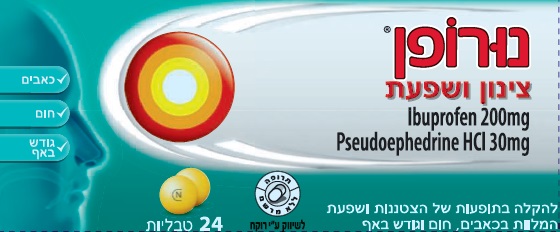Quest for the right Drug

נורופן צינון ושפעת NUROFEN COLD AND FLU (IBUPROFEN, PSEUDOEPHEDRINE HYDROCHLORIDE)
תרופה במרשם
תרופה בסל
נרקוטיקה
ציטוטוקסיקה
צורת מתן:
פומי : PER OS
צורת מינון:
טבליה : TABLETS
עלון לרופא
מינוניםPosology התוויות
Indications תופעות לוואי
Adverse reactions התוויות נגד
Contraindications אינטראקציות
Interactions מינון יתר
Overdose הריון/הנקה
Pregnancy & Lactation אוכלוסיות מיוחדות
Special populations תכונות פרמקולוגיות
Pharmacological properties מידע רוקחי
Pharmaceutical particulars אזהרת שימוש
Special Warning עלון לרופא
Physicians Leaflet
Pharmacological properties : תכונות פרמקולוגיות
Pharmacodynamic Properties
5.1 Pharmacodynamic properties Pharmacotherapeutic Group: Anti-inflammatory and antirheumatic products, propionic acid derivatives. Ibuprofen combinations. ATC Code: M01AE51 Ibuprofen is a propionic acid derivative, having analgesic, anti-pyretic and anti-inflammatory activity. The drug's therapeutic effects as a non-steroidal anti- inflammatory drug are thought to result from inhibitory activity on prostaglandin synthesis. Furthermore, ibuprofen reversibly inhibits platelet aggregation. Experimental data suggest that ibuprofen may competitively inhibit the effect of low dose aspirin (acetylsalicylic acid) on platelet aggregation when they are dosed concomitantly. Some pharmacodynamics studies show that when single doses of ibuprofen 400mg were taken with 8 h before or within 30 min after immediate release aspirin (acetylsalicylic acid) dosing (81mg), a decreased effect of ASA (acetylsalicylic acid) on the formation of thromboxane or platelet aggregation occurred. Although there are uncertainties regarding extrapolation of these data to the clinical situation, the possibility that regular, long-term use of ibuprofen may reduce the cardioprotective effect of low-dose acetylsalicylic acid cannot be excluded. No relevant effect is considered to be likely for occasional use (see section 4.5). Pseudoephedrine hydrochloride is used as a nasal and bronchial decongestant which acts by vasoconstriction to reduce oedema and nasal swelling. It is a stereoisomer of Ephedrine and has a similar action. It is a sympathomimetic agent with direct and indirect effects on adrenergic receptors. It has alpha- and beta-adrenergic activities and has stimulating effects on the central nervous system. It has a more prolonged, though less potent action than adrenaline. However, pseudoephedrine has been stated to have less pressor activity and central nervous system effects than ephedrine.
Pharmacokinetic Properties
5.2 Pharmacokinetic properties Ibuprofen is rapidly absorbed from the gastrointestinal tract, peak serum concentrations occurring 1-2 hours after administration. The elimination half- life is approximately two hours. Ibuprofen is metabolised in the liver to two major inactive metabolites and these together with unchanged ibuprofen are excreted by the kidney either as such or as conjugates. Excretion by the kidney is both rapid and complete. Ibuprofen is extensively bound to plasma proteins. Pseudoephedrine is absorbed from the gastrointestinal tract and is largely excreted in the urine unchanged, together with small amounts of a hepatic metabolite. It has an elimination half-life of several hours, which may be reduced by acidifying the urine.

שימוש לפי פנקס קופ''ח כללית 1994
לא צוין
תאריך הכללה מקורי בסל
לא צוין
הגבלות
לא צוין
מידע נוסף
עלון מידע לצרכן
07.07.20 - עלון לצרכן אנגלית 12.01.21 - עלון לצרכן עברית 07.07.20 - עלון לצרכן ערבית 26.02.23 - עלון לצרכן אנגלית 26.02.23 - עלון לצרכן עברית 26.02.23 - עלון לצרכן ערבית 15.11.23 - עלון לצרכן עברית 31.05.24 - עלון לצרכן אנגלית 31.05.24 - עלון לצרכן עברית 21.05.24 - עלון לצרכן ערבית 20.08.24 - עלון לצרכן עברית 07.07.20 - החמרה לעלון 12.01.21 - החמרה לעלון 29.03.24 - החמרה לעלוןלתרופה במאגר משרד הבריאות
נורופן צינון ושפעת